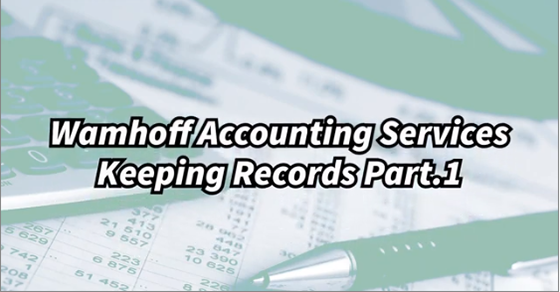It’s very important to keep good records, not only for your business, but also as an individual. In this video, Sandy Furuya goes over good record-keeping practices for your business.
Categories
- Employer Knowledge Base (17)
- Individual Taxes (361)
- News (31)
- Small Business Taxes (329)
Archives
- December 2024 (7)
- November 2024 (8)
- October 2024 (9)
- September 2024 (9)
- August 2024 (8)
- July 2024 (11)
- June 2024 (7)
- May 2024 (9)
- April 2024 (9)
- March 2024 (8)
- February 2024 (8)
- January 2024 (11)
- December 2023 (7)
- November 2023 (9)
- October 2023 (9)
- September 2023 (8)
- August 2023 (9)
- July 2023 (7)
- June 2023 (8)
- May 2023 (10)
- April 2023 (8)
- March 2023 (9)
- February 2023 (8)
- January 2023 (9)
- December 2022 (8)
- November 2022 (10)
- October 2022 (8)
- September 2022 (8)
- August 2022 (8)
- July 2022 (8)
- June 2022 (6)
- May 2022 (9)
- April 2022 (7)
- March 2022 (9)
- February 2022 (7)
- January 2022 (9)
- December 2021 (8)
- November 2021 (9)
- October 2021 (7)
- September 2021 (7)
- August 2021 (9)
- July 2021 (8)
- June 2021 (10)
- May 2021 (9)
- April 2021 (8)
- March 2021 (12)
- February 2021 (8)
- January 2021 (8)
- December 2020 (10)
- November 2020 (9)
- October 2020 (8)
- September 2020 (9)
- August 2020 (8)
- July 2020 (8)
- June 2020 (9)
- May 2020 (9)
- April 2020 (11)
- March 2020 (15)
- February 2020 (10)
- January 2020 (10)
- December 2019 (11)
- November 2019 (7)
- October 2019 (9)
- September 2019 (9)
- August 2019 (7)
- July 2019 (10)
- June 2019 (3)
- May 2019 (7)
- April 2019 (10)
- March 2019 (6)
- February 2019 (8)
- January 2019 (7)
- December 2018 (6)
- November 2018 (6)
- October 2018 (12)
- September 2018 (4)
- August 2018 (7)
- July 2018 (10)
- June 2018 (4)
- May 2018 (12)
- April 2018 (6)
- March 2018 (10)
- February 2018 (10)
- January 2018 (9)
- December 2017 (3)
- July 2016 (2)
- June 2016 (1)
- May 2016 (1)
- April 2016 (1)
- February 2016 (1)
- January 2016 (1)
- December 2015 (3)
- October 2015 (1)
- July 2015 (7)
- June 2015 (1)
Archive for Small Business Taxes – Page 45
If you’re considering buying or selling a business — or you’re in the process of a merger or acquisition — it’s important that both parties report the transaction to the IRS in the same way. Otherwise, you may increase your chances of being audited.
If a sale involves business assets (as opposed to stock or ownership interests), the buyer and the seller must generally report to the IRS the purchase price allocations that both use. This is done by attaching IRS Form 8594, “Asset Acquisition Statement,” to each of their respective federal income tax returns for the tax year that includes the transaction.
What’s reported?
When buying business assets in an M&A transaction, you must allocate the total purchase price to the specific assets that are acquired. The amount allocated to each asset then becomes its initial tax basis. For depreciable and amortizable assets, the initial tax basis of each asset determines the depreciation and amortization deductions for that asset after the acquisition. Depreciable and amortizable assets include:
- Equipment,
- Buildings and improvements,
- Software,
- Furniture, fixtures and
- Intangibles (including customer lists, licenses, patents, copyrights and goodwill).
In addition to reporting the items above, you must also disclose on Form 8594 whether the parties entered into a noncompete agreement, management contract or similar agreement, as well as the monetary consideration paid under it.
IRS scrutiny
The IRS may inspect the forms that are filed to see if the buyer and the seller use different allocations. If the IRS finds that different allocations are used, auditors may dig deeper and the investigation could expand beyond just the transaction. So, it’s in your best interest to ensure that both parties use the same allocations. Consider including this requirement in your asset purchase agreement at the time of the sale.
The tax implications of buying or selling a business are complicated. Price allocations are important because they affect future tax benefits. Both the buyer and the seller need to report them to the IRS in an identical way to avoid unwanted attention. To lock in the best postacquisition results, consult with us before finalizing any transaction
Are you considering purchasing a business vehicle? Do you understand depreciation methods and what you can deduct? I hope you find this video helpful as we walk through some options.
Summer is just around the corner, so you might be thinking about getting some vacation time. If you’re self-employed or a business owner, you have a golden opportunity to combine a business trip with a few extra days of vacation and offset some of the cost with a tax deduction. But be careful, or you might not qualify for the write-offs you’re expecting.
Basic rules
Business travel expenses can potentially be deducted if the travel is within the United States and the expenses are:
- “Ordinary and necessary” and
- Directly related to the business.
Note: The tax rules for foreign business travel are different from those for domestic travel.
Business owners and the self-employed are generally eligible to deduct business travel expenses if they meet the tests described above. However, under the Tax Cuts and Jobs Act, employees can no longer deduct such expenses. The potential deductions discussed in this article assume that you’re a business owner or self-employed.
A business-vacation trip
Transportation costs to and from the location of your business activity may be 100% deductible if the primary reason for the trip is business rather than pleasure. But if vacation is the primary reason for your travel, generally no transportation costs are deductible. These costs include plane or train tickets, the cost of getting to and from the airport, luggage handling tips and car expenses if you drive. Costs for driving your personal car are also eligible.
The key factor in determining whether the primary reason for domestic travel is business is the number of days you spend conducting business vs. enjoying vacation days. Any day principally devoted to business activities during normal business hours counts as a business day. In addition:
- Your travel days count as business days, as do weekends and holidays — if they fall between days devoted to business and it wouldn’t be practical to return home.
- Standby days (days when your physical presence might be required) also count as business days, even if you aren’t ultimately called upon to work on those days.
Bottom line: If your business days exceed your personal days, you should be able to claim business was the primary reason for a domestic trip and deduct your transportation costs.
What else can you deduct?
Once at the destination, your out-of-pocket expenses for business days are fully deductible. Examples of these expenses include lodging, meals (subject to the 50% disallowance rule), seminar and convention fees, and cab fare. Expenses for personal days aren’t deductible.
Keep in mind that only expenses for yourself are deductible. You can’t deduct expenses for family members traveling with you, including your spouse — unless they’re employees of your business and traveling for a bona fide business purpose.
Keep good records
Be sure to retain proof of the business nature of your trip. You must properly substantiate all of the expenses you’re deducting. If you get audited, the IRS will want to see records during travel you claim was for business. Good records are your best defense. Additional rules and limits apply to travel expense deductions. Please contact us if you have questions.
If you’re a business owner and you hire your children (or grandchildren) this summer, you can obtain tax breaks and other nontax benefits. The kids can gain on-the-job experience, save for college and learn how to manage money. And you may be able to:
- Shift your high-taxed income into tax-free or low-taxed income,
- Realize payroll tax savings (depending on the child’s age and how your business is organized), and
- Enable retirement plan contributions for the children.
It must be a real job
When you hire your child, you get a business tax deduction for employee wage expenses. In turn, the deduction reduces your federal income tax bill, your self-employment tax bill (if applicable), and your state income tax bill (if applicable). However, in order for your business to deduct the wages as a business expense, the work performed by the child must be legitimate and the child’s salary must be reasonable.
For example, let’s say a business owner operates as a sole proprietor and is in the 37% tax bracket. He hires his 16-year-old son to help with office work on a full-time basis during the summer and part-time into the fall. The son earns $10,000 during 2019 and doesn’t have any other earnings.
The business owner saves $3,700 (37% of $10,000) in income taxes at no tax cost to his son, who can use his 2019 $12,200 standard deduction to completely shelter his earnings.
The family’s taxes are cut even if the son’s earnings exceed his or her standard deduction. The reason is that the unsheltered earnings will be taxed to the son beginning at a rate of 10%, instead of being taxed at his father’s higher rate.
How payroll taxes might be saved
If your business isn’t incorporated, your child’s wages are exempt from Social Security, Medicare and FUTA taxes if certain conditions are met. Your child must be under age 18 for this to apply (or under age 21 in the case of the FUTA tax exemption). Contact us for how this works.
Be aware that there’s no FICA or FUTA exemption for employing a child if your business is incorporated or a partnership that includes nonparent partners.
Start saving for retirement early
Your business also may be able to provide your child with retirement benefits, depending on the type of plan you have and how it defines qualifying employees. And because your child has earnings from his or her job, he can contribute to a traditional IRA or Roth IRA. For the 2018 tax year, a working child can contribute the lesser of his or her earned income, or $6,000 to an IRA or a Roth.
Raising tax-smart children
As you can see, hiring your child can be a tax-smart idea. Be sure to keep the same records as you would for other employees to substantiate the hours worked and duties performed (such as timesheets and job descriptions). Issue your child a Form W-2. If you have any questions about how these rules apply to your situation, don’t hesitate to contact us.
If you read the Internal Revenue Code (and you probably don’t want to!), you may be surprised to find that most business deductions aren’t specifically listed. It doesn’t explicitly state that you can deduct office supplies and certain other expenses.
Some expenses are detailed in the tax code, but the general rule is contained in the first sentence of Section 162, which states you can write off “all the ordinary and necessary expenses paid or incurred during the taxable year in carrying on any trade or business.”
Basic definitions
In general, an expense is ordinary if it’s considered common or customary in the particular trade or business. For example, insurance premiums to protect a store would be an ordinary business expense in the retail industry.
A necessary expense is defined as one that’s helpful or appropriate. For example, let’s say a car dealership purchases an automatic defibrillator. It may not be necessary for the operation of the business, but it might be helpful and appropriate if an employee or customer suffers a heart attack.
It’s possible for an ordinary expense to be unnecessary — but, in order to be deductible, an expense must be ordinary and necessary.
In addition, a deductible amount must be reasonable in relation to the benefit expected. For example, if you’re attempting to land a $3,000 deal, a $65 lunch with a potential client should be OK with the IRS. (Keep in mind that the Tax Cuts and Jobs Act eliminated most deductions for entertainment expenses but retains the 50% deduction for business meals.)
Examples of not ordinary and unnecessary
Not surprisingly, the IRS and courts don’t always agree with taxpayers about what qualifies as ordinary and necessary expenditures.
In one case, a man engaged in a business with his brother was denied deductions for his private airplane expenses. The U.S. Tax Court noted that the taxpayer had failed to prove the expenses were ordinary and necessary to the business. In addition, only one brother used the plane and the flights were to places that the taxpayer could have driven to or flown to on a commercial airline. And, in any event, the stated expenses including depreciation expenses, weren’t adequately substantiated, the court added. (TC Memo 2018-108)
In another case, the Tax Court ruled that a business owner wasn’t entitled to deduct legal and professional fees he’d incurred in divorce proceedings defending his ex-wife’s claims to his interest in, or portion of, distributions he received from his LLC. The IRS and the court ruled the divorce legal fees were nondeductible personal expenses and weren’t ordinary and necessary. (TC Memo 2018-80)
Proceed with caution
The deductibility of some expenses is clear. But for other expenses, it can get more complicated. Generally, if an expense seems like it’s not normal in your industry — or if it could be considered fun, personal or extravagant in nature — you should proceed with caution. And keep records to substantiate the expenses you’re deducting. Consult with us for guidance.
Sign up for our Newsletter!
"*" indicates required fields
News & Articles
Client Portal
Contact Us
© Wamhoff Accounting Services | All Rights Reserved | Privacy Policy | Terms of Use | 636-573-1250 | Email Us






